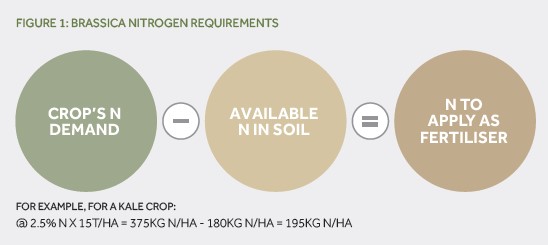THIS PROMOTIONAL FEATURE WAS PROVIDED BY BALLANCE AGRI-NUTRIENTS
Post-emergence nitrogen helps brassicas meet their yield potential. With a little help, kale, turnips, swedes and other brassica forage crops can provide high yields of quality feed.
As brassica crops are often grown in poor performing or low yielding paddocks, soil testing prior to sowing is recommended. This allows pH to be identified and corrected, and the phosphorous (P) and nitrogen (N) inputs that drive growth to be optimised based on soil fertility, target yield and economic return.
Starter fertiliser containing N and P at sowing is important for vigorous early seedling establishment. Drilling the seed with starter fertiliser ‘down the spout’ gets a supply of these key nutrients close to the developing seedling, and is especially beneficial when direct drilling, due to a lack of soil mineralisation with no-till methods.
Right time
After N and P are applied at sowing, sufficient N inputs are key for the crop to reach its yield potential.
An early side dressing of N boosts leaf growth and size, giving the plant more opportunity to form a full canopy to capture sunlight and outcompete weeds, resulting in improved yield. As a general rule, applying N as a single application before canopy closure is efficient. However, if very high amounts (>150kg N/ha) are required, split applications are recommended.
Targeting N application to high growth periods also reduces the risk of nitrate poisoning, which is elevated if N is applied too late in the season, close to grazing when growth is slowing. Getting N on early can also be more practical in summer dry locations where there is often a rush on contractors when the autumn rains arrive.
Right rate
The amount of N fertiliser required as side dressings can be worked out by determining the total crop demand, and then deducting N supplied by the soil and in starter fertiliser (see Figure 1).

An Available N test indicates the potential supply of available N from the soil. The test measures organic N that can be mineralised during the life of the crop. If planting into former permanent pasture, organic N levels may be quite high, effectively reducing the amount of fertiliser N needed.
Be realistic about target crop yield, taking into account what your soil and climate will support. The Ballance Brassica Calculator can help refine yield prediction and N application rate, enabling more efficient use of N.
Applying excess N does not increase yield, and just raises the protein content. When the crop is grazed, N is redeposited in urine patches, increasing the potential for N loss.
Excessive N application in conjunction with high background sulphur levels also increases the risk of SMCO, which can cause red water (haemoglobinuria) in grazing stock.
Right product
Cropzeal Boron Boost is a great choice of starter fertiliser, with every granule containing N, P and boron (to help prevent brown heart). It is typically applied at 100-200 kg/ha.
Cropping often uses large volumes of N and the potential for loss can be high. If using urea, volatilisation losses can be high unless 5–10mm of rainfall (or irrigation) occurs within 8 hours of application.
Using SustaiN (urea treated with Agrotain) will reduce this risk. Typical rates are 150-250 kg/ ha SustaiN as a side dressing, depending on time of sowing, yield potential and Available N test results. As timing of N applications are ideally based on the need of the crop, a product like SustaiN can reduce losses when conditions are not ideal.
Back to Real Farmer